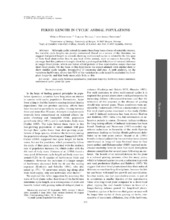| dc.contributor.author | Högstedt, Göran | eng |
| dc.contributor.author | Seldal, Tarald | eng |
| dc.contributor.author | Breistøl, Arild | eng |
| dc.date.accessioned | 2008-02-11T07:23:37Z | |
| dc.date.available | 2008-02-11T07:23:37Z | |
| dc.date.issued | 2005 | eng |
| dc.Published | Ecology 2005 69 (2): 373-378. Copyright by the Ecological Society of America | en |
| dc.identifier.issn | 0012-9615 | en_US |
| dc.identifier.uri | http://hdl.handle.net/1956/2580 | |
| dc.description.abstract | Although cyclic animal dynamics have long been a focus of scientific interest, the variable cycle lengths are poorly understood. Based on a review of the literature, we suggest that period length in animals showing multiannual cycles is related to the life span of their food plant rather than to any trait of the animal, such as mass or fecundity. We envisage that this pattern is brought about by a prolonged mobilization of induced defenses in longer lived plants, which can better afford periods of low reproductive output than can short-lived plants. On the basis of this hypothesis we expect animals with similar diets to show similar cycle lengths, irrespective of taxonomy and size. A path analysis, on the vertebrate herbivores, shows that 92% of the variation in cycle length is explained by foodplant longevity and that body mass adds little to this. | en_US |
| dc.language.iso | eng | eng |
| dc.publisher | Ecological Society of America | en_US |
| dc.subject | Bird | eng |
| dc.subject | Cyclic herbivore populations | eng |
| dc.subject | Food-plant longevity | eng |
| dc.subject | Herbivory | eng |
| dc.subject | Insect | eng |
| dc.subject | Mammals | eng |
| dc.subject | Multiannual cycles | eng |
| dc.subject | Plant life span | eng |
| dc.title | Period lenght in cyclic animal populations | en_US |
| dc.type | Peer reviewed | |
| dc.type | Journal article | |
| dc.subject.nsi | VDP::Matematikk og Naturvitenskap: 400::Zoologiske og botaniske fag: 480 | nob |
